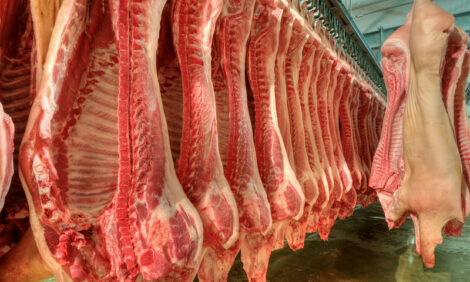



Blue Ear Epidemic Makes Farmers Wary
VIET NAM - Pig farmers are gradually returning to pig production following the recent epidemic of porcine reproductive and respiratory syndrome (PRRS), which cost more than US$1 million in just one province.Breeders in the northern province of Hai Duong were reluctant to raise pigs after the two-months' blue-ear epidemic, said Nguyen Van Tinh, deputy director of the provincial Department of Agriculture and Rural Development.
According to department statistics, about 600,000 pigs survived the epidemic, of which more than 100,000 are breeding sows. The remaining 500,000 porkers were sold to avoid the disease, so now many pig pens in the province are empty.
Bui Van Nhien, a farmer in Van To Commune in Tu Ky District, said his farm had 50 breeding sows and 450 porkers but he had to cull most of them to avoid them being affected by the recent epidemic.
He saod: "Now I want to raise pigs again, but I not only lack capital, I'm also worried the disease is not under control, so I must wait for a few more months to resume business."
Nguyen Van Thuan, a farmer in Lac Long Commune in Kinh Mon District, used to raise nearly 100 pigs at a time but when the epidemic started, he sold his herd and left the pens empty.
He said that pig-feed costs were high – 8,500 dong (VND; US$0.44) per kilo – whereas pork prices had dropped to only VND22,000 ($1.15) a kilo "so I cannot be adventurous," he said.
Mr Thuan also said he would continue breeding in a few months' time.
To make sure conditions are healthy for raising pigs again, the provincial veterinary department checked sanitation in Thai Hoa and Nhan Quyen communes, which were at the centre of the epidemic, on 1 July.
The inspection showed that local residents had cleaned up pig-raising areas well. Some householders even resumed breeding a month ago.
Dam Dinh Hue, a pig breeder in Binh Minh Commune in Binh Giang District, said he received 150 pigs from a reliable farm in Binh Xuyen Commune. "I will get 50 more to quickly continue breeding," he said.
Another farmer, Bui Huy Hanh who lives in Tai Son Commune in Tu Ky District, said his disease-control methods were thorough, so the epidemic did not strike his farm.
"I was ready to continue raising pigs more than a month ago," he said.
Deputy director of the provincial Department of Agriculture and Rural Development Nguyen Van Tinh said he had proposed that the Hai Duong People's Committee assist local farmers.
"The worrying factor is that breeding quality has dropped because many farmers let pigs breed indiscriminately with each other," he said.
The department has advised local residents to weed out bad stock and ordered farmers to clean up pens, breeding equipment and transport vehicles every week.
"Farmers should receive healthy, vaccinated breeders with clear origin and quarantine certificates," Mr Tinh said.
Veterinary workers have told farmers to use hygienic food for their pigs and reminded them to watch out for unusual health developments.
Hai Duong was the first province to be hit by blue-ear disease – and the first to control the disease.
Nine districts with a total of 65 communes in the province were hit by the disease. More than 9,800 pigs were identified with blue ear, of which 2,265 recovered and 7,391 culled.
The outbreak caused a loss of more than VND20 billion ($1.04 million) for the province, according to statistics of the provincial Department of Agriculture and Rural Development.
Further Reading
| - | Find out more information on porcine reproductive respiratory syndrome (PRRS) by clicking here. |







